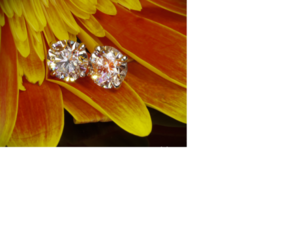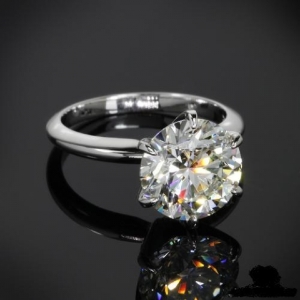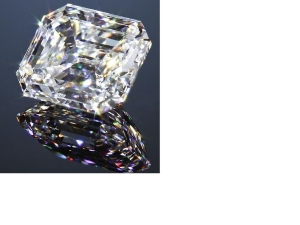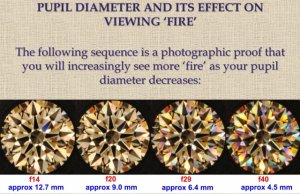- Joined
- Jan 7, 2009
- Messages
- 10,437
Texas Leaguer|1419440232|3807293 said:Interesting discussion Kenny. I think you have hit on many of the key aspects, but as Karl explains it is very complex and ever changing. I think that is what makes fire the most magical aspect of diamond light performance.
Here's a basic observation that I don't know if anyone has mentioned yet. In pictures taken in the real world, well cut diamonds are reflecting various things in the environment including contrasty areas as well as colorful areas. Therefore it is easy to mistake some colored reflections in these pictures (and sometimes in real life) for dispersive color (fire).
There are all kinds of things (light source(s), diamond, environment, observer) that can impact the appearance of fire, how likely it is to be observed, how big the colored sparkles are,and how saturated various hues appear. (An unsaturated hue is essentially a pastel). Color mixing is a possibility both in dispersion on top of reflected color, as well as (I believe) mixing of two dispersive colors on a virtual facet.
Rockdiamond|1419447570|3807333 said:Who defines "Ideal Optics"?
Rhino|1419441940|3807305 said:a. ideal optics
c. since diamonds with ideal optics are the best at capturing and reflecting back the surrounding environment you are also seeing reflections of colors within that environment
Rockdiamond|1419454596|3807399 said:thanks Jon- since this an objective discussion, can we use the term "Ideal Optics as defined by AGSL
David, AGSL is named here due to their system identified with the term "Ideal"Rockdiamond|1419454596|3807399 said:thanks Jon- since this an objective discussion, can we use the term "Ideal Optics as defined by AGSL".
It's a proprietary term- like a brand name, as opposed to some sort of scientific description.
Can we agree that other stones, not termed "Ideal" by AGSL will also exhibit fire- In fact, some large faceted shallow diamonds- clearly not termed "ideal" by AGSL may exhibit MORE fire if the facet placement, size and lighting sources are aligned.
I love AGSL Ideal stones- but I do think there's times that aspects attributed "Ideal" optics, as defined by AGSL are overstated.
DiaGem|1419456152|3807408 said:David, AGSL is named here due to their system identified with the term "Ideal"Rockdiamond|1419454596|3807399 said:thanks Jon- since this an objective discussion, can we use the term "Ideal Optics as defined by AGSL".
It's a proprietary term- like a brand name, as opposed to some sort of scientific description.
Can we agree that other stones, not termed "Ideal" by AGSL will also exhibit fire- In fact, some large faceted shallow diamonds- clearly not termed "ideal" by AGSL may exhibit MORE fire if the facet placement, size and lighting sources are aligned.
I love AGSL Ideal stones- but I do think there's times that aspects attributed "Ideal" optics, as defined by AGSL are overstated.
Do other cuts exhibit fire (e.g. Small,medium,large,X-Large etc..)? Sure they do, and they are potentially beautiful as well.
But...,
We are not talking "specifically" rounds are we...
When we cut to Ideal optics, we are able to control the sizes of the VF we design so we can control fire effect...
In random generic cuts, no matter how beautiful, the fire and other optical properties are not controlled as designed cuts are...
We attribute AGSL's "Ideal" term here because they are the authority on cut at the moment....



DiaGem|1419456152|3807408 said:We attribute AGSL's "Ideal" term here because they are the authority on cut at the moment....
kenny|1419381711|3806828 said:Rhino, did you say something?
Hope you can contribute to this thread about what causes us to see pastels.
I really think it is unrelated to cut.
Rather, it is a function of lighting in the environment.
Try to stay on focus, you are swaying and loosing the point of this thread..., or it's title...Rockdiamond|1419457701|3807414 said:DiaGem|1419456152|3807408 said:David, AGSL is named here due to their system identified with the term "Ideal"Rockdiamond|1419454596|3807399 said:thanks Jon- since this an objective discussion, can we use the term "Ideal Optics as defined by AGSL".
It's a proprietary term- like a brand name, as opposed to some sort of scientific description.
Can we agree that other stones, not termed "Ideal" by AGSL will also exhibit fire- In fact, some large faceted shallow diamonds- clearly not termed "ideal" by AGSL may exhibit MORE fire if the facet placement, size and lighting sources are aligned.
I love AGSL Ideal stones- but I do think there's times that aspects attributed "Ideal" optics, as defined by AGSL are overstated.
Do other cuts exhibit fire (e.g. Small,medium,large,X-Large etc..)? Sure they do, and they are potentially beautiful as well.
But...,
We are not talking "specifically" rounds are we...
When we cut to Ideal optics, we are able to control the sizes of the VF we design so we can control fire effect...
In random generic cuts, no matter how beautiful, the fire and other optical properties are not controlled as designed cuts are...
We attribute AGSL's "Ideal" term here because they are the authority on cut at the moment....
Hi Yoram!
We do see a few aspects differently- and it's a subject we never tire of discussing.
Putting everything else aside- I strongly disagree with the part in bold.
The thread is about fire- no mention of fire in AGSL graded stones i the title.
If we are comparing GIA and AGSL, we'd have a discussion about which lab has more authority- and I can see a very good case for AGSL in that discussion.
Or if we limit discussion to only AGSL definitions, of course they are the authority.
But that's a very limited discussion as we have eliminated the vast majority of all stones available. Many of which will be considered the equivalent to "ideal" cut in terms of quality of cut by many knowledgeable observers
We only have to look at the AGSL Princess Cut grade to see dispel the notion AGSL is the ultimate cut authority. The AGS stones are consistently gorgeous- but there's plenty of other models which are equally well cut- and many would say more beautiful. I believe this is the reason the grade has never been widely embraced.
If one wants a diamond that looks exactly like the next one, and the look they want is the type of optics AGSL grades promote, then the consistently and control you speak of is a necessity.
However I'll never buy the notion that stones are somehow "better" cut simply because they fit a mold.
Getting back to fire, there's surely non ideal cut stones with more potential for fire than another given ideal cut stones
MelisendeDiamonds|1419454257|3807395 said:Rhino|1419441940|3807305 said:a. ideal optics
c. since diamonds with ideal optics are the best at capturing and reflecting back the surrounding environment you are also seeing reflections of colors within that environment
'Ideal optics" in a round brilliant at least what is marketed on Pricescope as "Ideal H&A" as ideal is not optimized for fire not even close. 34.5/40.8/77 A "Tolk Ideal" is balanced with good brightness and fire, brightness is favoured over fire.
Other combinations can produce more fire at the expense of brightness.
Most fire from Round Brilliant is seen in the arrows, it is caused by clipping not by dispersion.
Part of white light is "clipped" making the arrows colored.
Larger VFs allow more chance for clipping and greater seperation of colors allowing the observance of more fire.
MelisendeDiamonds|1419461070|3807435 said:kenny|1419381711|3806828 said:Rhino, did you say something?
Hope you can contribute to this thread about what causes us to see pastels.
I really think it is unrelated to cut.
Rather, it is a function of lighting in the environment.
Seems plausible, pastels are washed out colors. Mix stronger colored light from narrow point sources with diffuse white light and I'd expect more pastels than saturated colors.

Rhino|1419453896|3807392 said:Rockdiamond|1419447570|3807333 said:Who defines "Ideal Optics"?
AGS
DiaGem|1419462732|3807441 said:Try to stay on focus, you are swaying and loosing the point of this thread..., or it's title...
We are speaking of facet size, VF size and the way they display the colors of the spectrum as flashes of colorful fire.
This directly relates to the design and the ability to complement crown and pavilion facets in such a manner which has the potential to display unobscured pavilion facets thus enabling controlled flash size and on-off events.
The more precise the cut within its design the more control in the sizes and speed of the fire flashes.
Not talking about "beauty or better" etc, it won't help steering it in that direction.
Generics cuts have random fire flashes vs. designed cuts which can potentially have planned flashes.
And yes, what can you do, currently AGSL holds the title to "cut grading" authority...., unfortunately they are limiting innovationbut they are in their respected position the authority!! So when we want to talk optical symmetry and it's advantages we talk the "Ideal" language, it's simply more scientific.
Nothing to do with beauty of more/less or better...
Rockdiamond|1419561733|3807753 said:But AGSL cut grading is not "more scientific" than GIA cut grading. It may be more precisely calibrated in result- but there's no doubt GIA possess far grater resources for scientific testing than AGSL. If GIA wanted to narrow the EX cut grade to an even more finite window than AGSL, they certainly have the technology to do so.
which is why the term has become useless.Wink|1419549331|3807715 said:Rhino|1419453896|3807392 said:Rockdiamond|1419447570|3807333 said:Who defines "Ideal Optics"?
AGS
This!
Rockdiamond|1419561733|3807753 said:DiaGem|1419462732|3807441 said:Try to stay on focus, you are swaying and loosing the point of this thread..., or it's title...
We are speaking of facet size, VF size and the way they display the colors of the spectrum as flashes of colorful fire.
This directly relates to the design and the ability to complement crown and pavilion facets in such a manner which has the potential to display unobscured pavilion facets thus enabling controlled flash size and on-off events.
The more precise the cut within its design the more control in the sizes and speed of the fire flashes.
Not talking about "beauty or better" etc, it won't help steering it in that direction.
Generics cuts have random fire flashes vs. designed cuts which can potentially have planned flashes.
And yes, what can you do, currently AGSL holds the title to "cut grading" authority...., unfortunately they are limiting innovationbut they are in their respected position the authority!! So when we want to talk optical symmetry and it's advantages we talk the "Ideal" language, it's simply more scientific.
Nothing to do with beauty of more/less or better...
Yoram- to your point about AGSL cut grading being "scientific":
Taken in context with your statements about the science behind optical symmetry, precision in cutting and unobscured pavilion facets, the term makes perfect sense.
But AGSL cut grading is not "more scientific" than GIA cut grading. It may be more precisely calibrated in result- but there's no doubt GIA possess far grater resources for scientific testing than AGSL. If GIA wanted to narrow the EX cut grade to an even more finite window than AGSL, they certainly have the technology to do so.
The point is that the cut grades of both labs are subjective
This is not to imply there's anything "wrong" with AGSL Ideal cut grading. AGSL studies, and cut grading are a tremendous asset to our industry.
But it can't cure the common cold. And ideal optics, while they may produce lovely fire- are not the best recipe for "fire"
Sorry for the threadjack, but I did not bring ideal optics into the discussion- or beauty.
I will answer you with your own words on this one....Rockdiamond|1419454596|3807399 said:....In fact, some large faceted shallow diamonds- clearly not termed "ideal" by AGSL may exhibit MORE fire if the facet placement, size and lighting sources are aligned...
Are these pastels or pale rainbow hues? If the camera exposure was changed could they become regular fire?lknvrb4|1419506826|3807578 said:I noticed with my cushion brilliant that the pastels usually show up in the NSWE position only, weird.
Perhaps slight movements between spectral colors? But there goes the fire logic...Garry H (Cut Nut)|1419587340|3807834 said:Are these pastels or pale rainbow hues? If the camera exposure was changed could they become regular fire?lknvrb4|1419506826|3807578 said:I noticed with my cushion brilliant that the pastels usually show up in the NSWE position only, weird.
What is the boaundary between what people are calling pastel and regular fire?
is it possible that there is simply a bright reflection off the facet that has some fire showing which reduces the apparent brightness of the fire.
lknvrb4|1419506826|3807578 said:I noticed with my cushion brilliant that the pastels usually show up in the NSWE position only, weird.
Serg said:lknvrb4|1419506826|3807578 said:I noticed with my cushion brilliant that the pastels usually show up in the NSWE position only, weird.
Try take photos with different apertures. for smaller aperture you have to receive more saturated flashes

